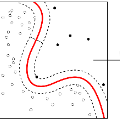This study presents an open source method for detecting 3D printing anomalies by comparing images of printed layers from a stationary monocular camera with G-code-based reference images of an ideal process generated with Blender, a physics rendering engine. Recognition of visual deviations was accomplished by analyzing the similarity of histograms of oriented gradients (HOG) of local image areas. The developed technique requires preliminary modeling of the working environment to achieve the best match for orientation, color rendering, lighting, and other parameters of the printed part. The output of the algorithm is a level of mismatch between printed and synthetic reference layers. Twelve similarity and distance measures were implemented and compared for their effectiveness at detecting 3D printing errors on six different representative failure types and their control error-free print images. The results show that although Kendall tau, Jaccard, and Sorensen similarities are the most sensitive, Pearson r, Spearman rho, cosine, and Dice similarities produce the more reliable results. This open source method allows the program to notice critical errors in the early stages of their occurrence and either pause manufacturing processes for further investigation by an operator or in the future AI-controlled automatic error correction. The implementation of this novel method does not require preliminary data for training, and the greatest efficiency can be achieved with the mass production of parts by either additive or subtractive manufacturing of the same geometric shape. It can be concluded this open source method is a promising means of enabling smart distributed recycling for additive manufacturing using complex feedstocks as well as other challenging manufacturing environments.
翻译:本研究通过将固定的单层照相机的印刷层图像与物理学成像引擎Blender生成的理想过程的G-code参考图像进行比较,从而发现3D印刷异常现象。通过分析当地图像区域方向梯度(HOG)的直方图相似性,从而识别了视觉偏差。发达技术要求对工作环境进行初步建模,以取得对方向、颜色显示、照明和其他印刷部分参数的最佳匹配。算法的产出是印刷和合成参考层之间的不匹配程度。实施了12项类似和距离措施,并比较了在发现6种不同代表性故障类型3D印刷错误及其控制无误打印图像方面的效力。结果显示,尽管Kendall Tau、Jaccard和Sorensen等地方图像的直方图相似性非常相似性,但Pearson r、Spearman rho、cosine和Dice相似性能产生更可靠的结果。这种开放源法使程序能够发现其出现早期的关键错误,或者暂停制造过程,或者由操作者进行进一步调查以3D打印的印刷作业方式进行进一步调查,但最终的制造方法必须采用最可靠的方法。
相关内容
网页浏览器的排版引擎(Layout Engine或Rendering Engine)也被称为浏览器内核、页面渲染引擎或樣版引擎,它负责取得网页的内容 (HTML、XML、图像等等)、整理訊息(例如加入CSS等),以及计算网页的显示方式,然后会输出至显示器或打印机。所有网页浏览器、电子邮件客户端以及其它需要根據表示性的標記語言 (Presentational markup) 來显示内容的应用程序都需要排版引擎。
在Mozilla将其排版引擎(Gecko)作为独立于浏览器的一个配件之后,「排版引擎」这个词汇才被广泛使用。也就是说,除了Mozilla浏览器,其它浏览器也可以使用Gecko作自己排版引擎。




